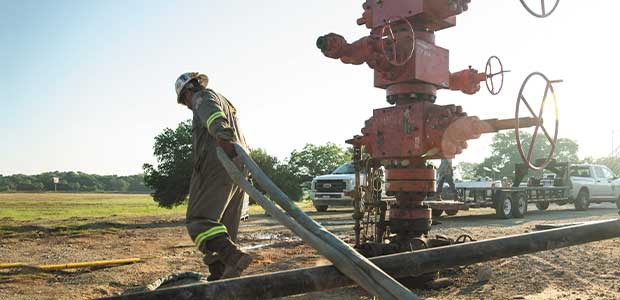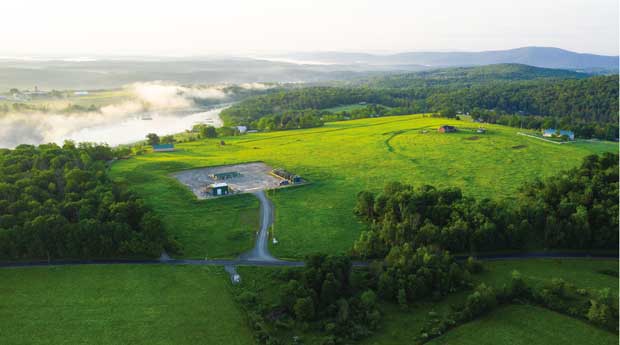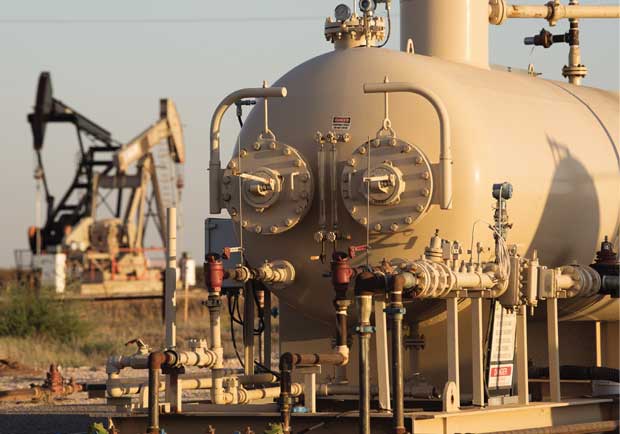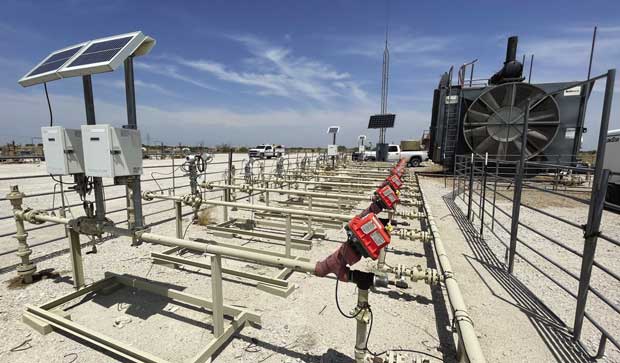
Mid-Continent Operators Pursuing Range Of Opportunities
By Danny Boyd
It may seem all but forgotten to the history books, but modern shale play concepts that recast global energy markets over the past 25 years began quietly in the Fort Worth Basin, on the fringes of Mid-Continent activity. In the American heartland far out of the industry spotlight, a simple but profound geologic theory was patiently put to the test: low-permeability shales were source rocks actively generating hydrocarbons.
After years of experimentation, voila! Horizontal drilling and multistage hydraulic fracturing first unlocked natural gas and then oil at flow rates that would have been incomprehensible for onshore U.S. basins only a few years prior. The energy world was changed forever. Sleeping unconventional giants such as the Permian, the Williston, Appalachia and the Haynesville were awakened, propelling U.S. output to historic daily highs of 13.5 million barrels of oil and 125 billion cubic feet of gas.
The “discovery” of the Barnett Shale in a basin that had already been producing gas for decades is now the stuff of industry legend, but it begs the question: What will be the next Barnett? Is there another huge opportunity hiding in plain sight in a Mid-Continent region where conventional geology is still very much in operational focus?
Time will tell, of course, but as companies continue the search for the next big thing in the Mid-Continent, they are quite content to take advantage of attractive operating economics in tried-and-true fields. Anadarko Basin and Barnett Shale resource play operators point out that they can exploit unconventional rocks for a fraction of the cost of playing in the major shale basins, and often get liquids-rich production streams in the process. Stacked zones in the Anadarko give them lots of optionality, while vintage Barnett wells with now-antiquated frac designs tee up plenty of recompletion potential. At the same time, new generations of family-owned companies are drilling conventional targets across the area and strategically acquiring properties to provide room to grow.
Large Barnett Inventory
BKV Corporation, the largest Barnett Shale producer, has assembled a drilling inventory of 500 new wells and identified 2,000 candidates for refracturing, according to Chief Executive Officer Chris Kalnin. More assets could be added as the Denver-based company keeps an eye out for select acreage opportunities.
“We obviously would love to acquire additional positions in the Barnett,” Kalnin says. “The trick to that is getting it at the right price and not overpaying, but there is still running room in the basin.”
As the largest Barnett Shale producer, BKV Corporation has a 500-well drilling inventory in addition to some 2,000 candidates in its inventory of refracturing candidates. BKV has now completed more than 400 refrac treatments, which is more than any other company in the country.
BKV, which also has power generation and carbon capture operations in the Lone Star state, entered the Fort Worth Basin in 2020 after buying the Barnett assets of Devon Energy. Shortly thereafter, the company added upstream assets and midstream infrastructure from XTO Energy. With an eye on additions, BKV continues to restimulate wells first fractured during the earliest days of the unconventional revolution.
Since entering the Barnett, the company has completed 400 refracs—more than any company in the country, Kalnin reports, pointing to Enverus data.
Early stimulation designs tended to leave behind plenty of virgin rock. On refracs, BKV is spacing perforation clusters every 30-50 feet on wells initially completed with 300–400-foot spacing intervals. The restimulations are paying off, Kalnin says.
A $500,000 bullhead refrac using liners with sleeves can add 1 billion cubic feet equivalent of proven reserves on wells with 20-25% liquids that BKV has 80% or more net interest revenue. One-year declines on refracs are in the 50%-60% range.
The economics are compelling at today’s gas prices, Kalnin insists. Helping matters is the brittle nature of the shale that makes it easy to fracture. Also, there are water ponds located near all refrac sites, and plenty of midstream capacity for gathering, processing and taking away the new production.
One of two frac crews is currently alternating between refracs and stimulating new infill wells drilled with one working rig. Up to 30 infills wells will be drilled this year, including some with two-mile laterals. In the early days, laterals were often only a few thousand feet long, but new wells now include design options to tap virgin rock via doglegs and U-shaped laterals, Kalnin notes.
Included in BKV’s drilling projects is an ongoing assessment of the Upper Barnett in Denton and Wise counties, where the company is working to identify the right frac design, says Kalnin. The Lower Barnett has historically been the most prolific layer, but the Upper interval includes unlocked potential in places. A large frac barrier separates the two, he points out.
To avoid frac interference between new infill wells and nearby producers, the company has mastered an approach that maps unstimulated rock in existing wells. Completion designs on the new wells can skip stages that might interfere with virgin rock best tapped with a refrac on an existing well.
“Sometimes, we will intentionally frac into adjacent wells to actually stimulate portions of them,” Kilnan reveals. “On a bigger frac on a primary well, we are getting a production uplift from the neighborhood of offset wells around it. That is because we are stimulating additional untapped rock that can flow into those other wellbores.”
Largest Anadarko Player
While Diversified Energy Company has dry gas assets in the Barnett Shale, its focus as of late is on Oklahoma, where the publicly held company is now the largest player in the western Anadarko after its acquisition of Maverick Natural Resources, reports Senior Vice President of Investor Relations Douglas Kris.
The $1.28 billion cash-and-stock deal for Maverick closed in mid-March. The acquisition included 750,000 Anadarko acres along with assets in the Permian and elsewhere. Diversified concentrates on workovers to improve existing production instead of drilling, but the Maverick transaction includes a joint venture with Mewbourne Oil to drill liquids-rich acreage prospective of the Cherokee, he says. Under the JV, Diversified provides the acreage and some capital and maintains a non-operated interest position.
After closing on its acquisition of Maverick Natural Resources in March, Diversified Energy Company now ranks as the largest leaseholder in the western Anadarko Basin. The $1.28 billion cash-and-stock deal included 750,000 Anadarko acres, assets in the Permian and elsewhere, and a joint venture with Mewbourne Oil to drill liquids-rich acreage prospective of the Cherokee.
“For us, it is a way to get some additional production under our operating platform without having to build out a drilling and completions team or a whole accompaniment of development and operational personnel,” Kris remarks. “Mewbourne is a high-quality private operator with very strong technical and operational expertise. We let them do the drilling and development work.”
Maverick’s Anadarko assets tripled Diversified’s daily production in the region from 18,000 to 54,000 barrels of oil equivalent and includes plenty of workover candidates, he says. A year ago, the company conducted 300 workovers in Oklahoma, including on SCOOP and STACK wells, consisting mostly of smaller projects. Average costs per project ranged from $40,000 to $50,000, Kris reveals, and payback was typically realized within two months.
Workovers have boosted company production in that operating area by about 10%, which offsets a similar overall corporate production decline, according to Kris. To further support cash flow, Diversified will continue a strategy of selective acreage divestment where sales are attractive, he says. Previous Anadarko Basin divestments have been to several public and private operators in the area that are looking to expand their footprint in the liquids-rich Cherokee play.
With some companies being priced out of other basins, more are coming to the Anadarko, Kris points out, boosting Diversified chances of earning more per acre on divested assets. Over the past year and a half, the Birmingham, Al-based company’s sales price per divested acre doubled to more than $1,500.
Diversified first entered Oklahoma in 2021 by acquiring Tapstone & Tanos assets in the region. In 2024, the company spent $600 million on acquisitions across the country that included bolt-ons ranging from $60 million to $400 million without any additional general and administrative costs, Kris comments.
The acquisition of Maverick from EIG Global Energy Partners comes with operational and G&A cost savings of at least $50 million, allows for growth in an industry-friendly state, and is upgraded by favorable contracts with midstream companies, he adds. Takeaway for liquids and gas is more than adequate with Diversified’s production easily shipped to the Gulf Coast for LNG exports and industrial users, Kris concludes.
Barnett Refracturing
Low-decline production on 175,000 acres near premium markets supports Bedrock Energy Partners’ development plans in the Barnett Shale, Chief Financial Officer Nate Grady says.
“We can get our gas to the Gulf Coast to liquified natural gas export hubs, and we can help service growing power demand for artificial intelligence centers as they build out in the Dallas-Fort Worth area, which is the second-largest AI data center area in the country and arguably the fastest growing one over the next few years,” he relates. “The increase in gas prices rolling into 2025 has also considerably helped the general atmosphere in the Barnett.”
Bedrock Energy Partners’ lease position in Parker and Wise counties includes 900 horizontal wells on 175,000 acres near premium markets that produce 130 million cubic feet a day. While the company has drilled 22 Barnett wells and has identified 17 new well locations, a key part of its strategy is refracturing legacy completions, some of which have perforations as sparsely spaced as every 1,000 feet.
Owned by Mountain Capital Management, the Houston company is gearing up for restimulation projects and eyeing new drilling with improved gas futures pricing. During times when the gas market is soft, Bedrock’s strategy is to focus more on maintaining production and aggressively reducing debt.
The company acquired Barnett assets from EnerVest in late 2017 and took over operations two years later. The “b-e-d” in the Bedrock name comes from Braden Exploration, Encana, and Denbury Resources, former Barnett players who first developed the acreage that the company subsequently since acquired, says Vice President of Operations Hans Dube.
Its current position in Parker and Wise counties now includes 900 horizontal wells producing 130 million cubic feet a day. Since inception, Bedrock has drilled 22 Barnett wells. The company has identified 17 additional new well locations that can be drilled for $4 million-$4.1 million each with laterals extending to 9,000 feet, Dube says.
Refrac prospects abound. The amount of unfractured rock on legacy wells provides a lower cost option to grow production, Dube points out. Numerous wells have plenty of virgin rock behind pipe in the heel and lengthy stretches of unstimulated lateral. In the early days, some 5,000-foot laterals were completed with perforations every 1,000 feet.
“Some of these laterals were completed with a five-stage frac, or at most, a 10-stage frac,” Dube says. “You can imagine the amount of rock that is not being cracked.”
Some Barnett refrac designs include placing a 3.5-inch liner inside the casing from the heel to midway down the lateral, he explains. From the midpoint to the toe, the lateral is stimulated with a bullhead frac consisting only of water.
From midway back to the heel, the well can be refractured with conventional perforations in previously unfractured areas in stages isolated with plugs like a typical new well stimulation. A bullhead refrac can be done for $200,000-$250,000 with a more involved restimulation with a liner costing up to $750,000 in some cases, Dube reports.
Technology advancements are adding efficiencies. One innovation developed by the Bedrock field operating and engineering staff helps lease operators optimize production using automation equipment and programming. According to Dube, the tool makes changes to the gas-assisted plunger lift (GAPL) settings such that production is optimized around the clock. This tool has facilitated the low production decline across the asset.
Conventional Opportunities
In Central Oklahoma, where the first wells were drilled a century ago, conventional operator Columbus Oil is looking for opportunities to fuel growth by acquiring existing wells, reviving dormant wellbores, and becoming a contract operator, says President Clint Reitz.
Operating 29 wells producing from the Viola, Wilcox and other zones in Seminole and Pottawattamie counties, Columbus Oil has acquired single wells, but contract operations would open growth options by giving long-time area producers the option to retire and retain their assets.
“It is the best of both worlds for us and for other operators,” Reitz says. “We can keep tabs on wells for other producers, and they continue to get checks for their oil and gas production. They have the option to retire and not worry about day-to-day operations.”
At some point, drilling opportunities would be welcome, but capital limitations and risk make pursuing other growth avenues best for now, he adds.
An aerospace and mechanical engineer by trade, Reitz is busy learning seismic and other scientific aspects of the oil and gas business and getting a commercial driver’s license so the company can save money hauling its own produced water. He is also learning by befriending other operators who share their experiences.
Columbus Oil is an example of a company being passed down from one generation to the next—in this case, to Reitz and his wife, Whitney. Two years ago, Whitney’s mother, Darlene Wallace, turned over operations to the Reitzes after leading the company for more than two decades.
A board member at the National Stripper Well Association and former director at the Domestic Energy Producers Alliance founded by Continental’s Harold Hamm, Wallace says growth through acquiring existing production in the region is desirable but can take a while.
“At times, it seems as if people pass away before things become available, because so many long-time producers here have a hard time letting go. It is not about the money—it is a life,” Wallace says.
The company was founded in 1974 by Wallace’s late husband, Dan Wallace, who earlier launched Wallace Acid Frac in Seminole, Ok. He divested of the service company and carried the note for an acquiring employee so he could focus on the producing company, which was his first love, she recalls. Supported over the years by 13 investing partners, Columbus drilled and added assets in robust times to ride out lean years, Wallace states.
After Dan’s passing, Wallace took over operations at a time when female managers were uncommon. Her story caught the attention of Hamm and others, and she began sharing her experience with Washington policymakers.
Despite the age of some wells—Columbus still produces one in Seminole County drilled 98 years ago—reworking producing conventional wells has yielded attractive increases over the years, Wallace insists. As a case in point, she references a well that had been shut down in the 1990s because of a casing leak. The well had been making 10 barrels a day when it was shut in.
“We decided to replace the casing to see if we could get it back on line. The well came back making 40 barrels a day for over nine months,” Wallace says. “That same well only makes about three barrels a day now, but it has made the company a lot of money over the years!”
For other great articles about exploration, drilling, completions and production, subscribe to The American Oil & Gas Reporter and bookmark www.aogr.com.









